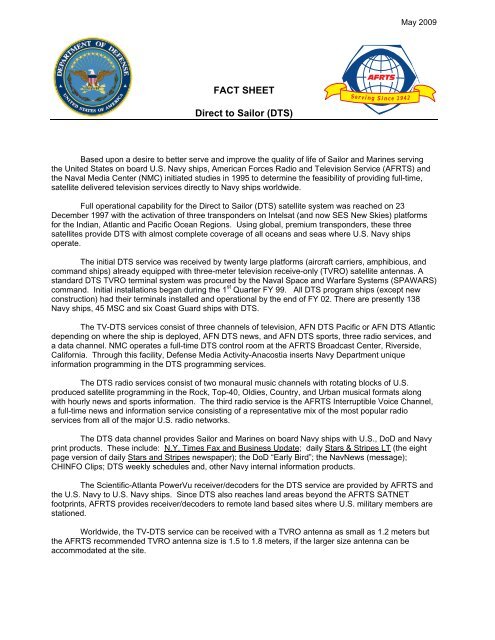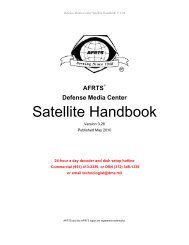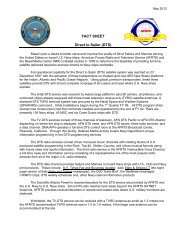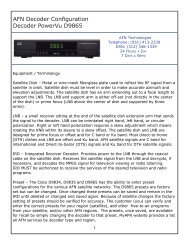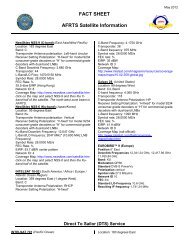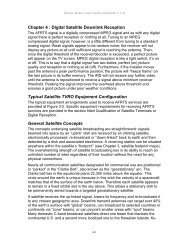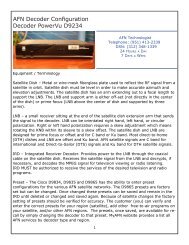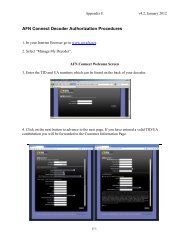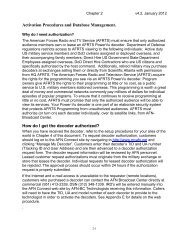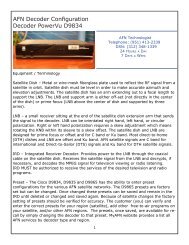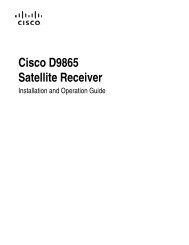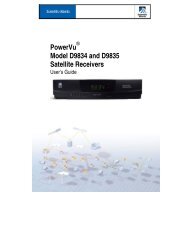American Forces Information Service February 1998 - afrts
American Forces Information Service February 1998 - afrts
American Forces Information Service February 1998 - afrts
Create successful ePaper yourself
Turn your PDF publications into a flip-book with our unique Google optimized e-Paper software.
FACT SHEET<br />
Direct to Sailor (DTS)<br />
S e r v i n g Since 1942<br />
May 2009<br />
Based upon a desire to better serve and improve the quality of life of Sailor and Marines serving<br />
the United States on board U.S. Navy ships, <strong>American</strong> <strong>Forces</strong> Radio and Television <strong>Service</strong> (AFRTS) and<br />
the Naval Media Center (NMC) initiated studies in 1995 to determine the feasibility of providing full-time,<br />
satellite delivered television services directly to Navy ships worldwide.<br />
Full operational capability for the Direct to Sailor (DTS) satellite system was reached on 23<br />
December 1997 with the activation of three transponders on Intelsat (and now SES New Skies) platforms<br />
for the Indian, Atlantic and Pacific Ocean Regions. Using global, premium transponders, these three<br />
satellites provide DTS with almost complete coverage of all oceans and seas where U.S. Navy ships<br />
operate.<br />
The initial DTS service was received by twenty large platforms (aircraft carriers, amphibious, and<br />
command ships) already equipped with three-meter television receive-only (TVRO) satellite antennas. A<br />
standard DTS TVRO terminal system was procured by the Naval Space and Warfare Systems (SPAWARS)<br />
command. Initial installations began during the 1 st Quarter FY 99. All DTS program ships (except new<br />
construction) had their terminals installed and operational by the end of FY 02. There are presently 138<br />
Navy ships, 45 MSC and six Coast Guard ships with DTS.<br />
The TV-DTS services consist of three channels of television, AFN DTS Pacific or AFN DTS Atlantic<br />
depending on where the ship is deployed, AFN DTS news, and AFN DTS sports, three radio services, and<br />
a data channel. NMC operates a full-time DTS control room at the AFRTS Broadcast Center, Riverside,<br />
California. Through this facility, Defense Media Activity-Anacostia inserts Navy Department unique<br />
information programming in the DTS programming services.<br />
The DTS radio services consist of two monaural music channels with rotating blocks of U.S.<br />
produced satellite programming in the Rock, Top-40, Oldies, Country, and Urban musical formats along<br />
with hourly news and sports information. The third radio service is the AFRTS Interruptible Voice Channel,<br />
a full-time news and information service consisting of a representative mix of the most popular radio<br />
services from all of the major U.S. radio networks.<br />
The DTS data channel provides Sailor and Marines on board Navy ships with U.S., DoD and Navy<br />
print products. These include: N.Y. Times Fax and Business Update; daily Stars & Stripes LT (the eight<br />
page version of daily Stars and Stripes newspaper); the DoD “Early Bird”; the NavNews (message);<br />
CHINFO Clips; DTS weekly schedules and, other Navy internal information products.<br />
The Scientific-Atlanta PowerVu receiver/decoders for the DTS service are provided by AFRTS and<br />
the U.S. Navy to U.S. Navy ships. Since DTS also reaches land areas beyond the AFRTS SATNET<br />
footprints, AFRTS provides receiver/decoders to remote land based sites where U.S. military members are<br />
stationed.<br />
Worldwide, the TV-DTS service can be received with a TVRO antenna as small as 1.2 meters but<br />
the AFRTS recommended TVRO antenna size is 1.5 to 1.8 meters, if the larger size antenna can be<br />
accommodated at the site.


